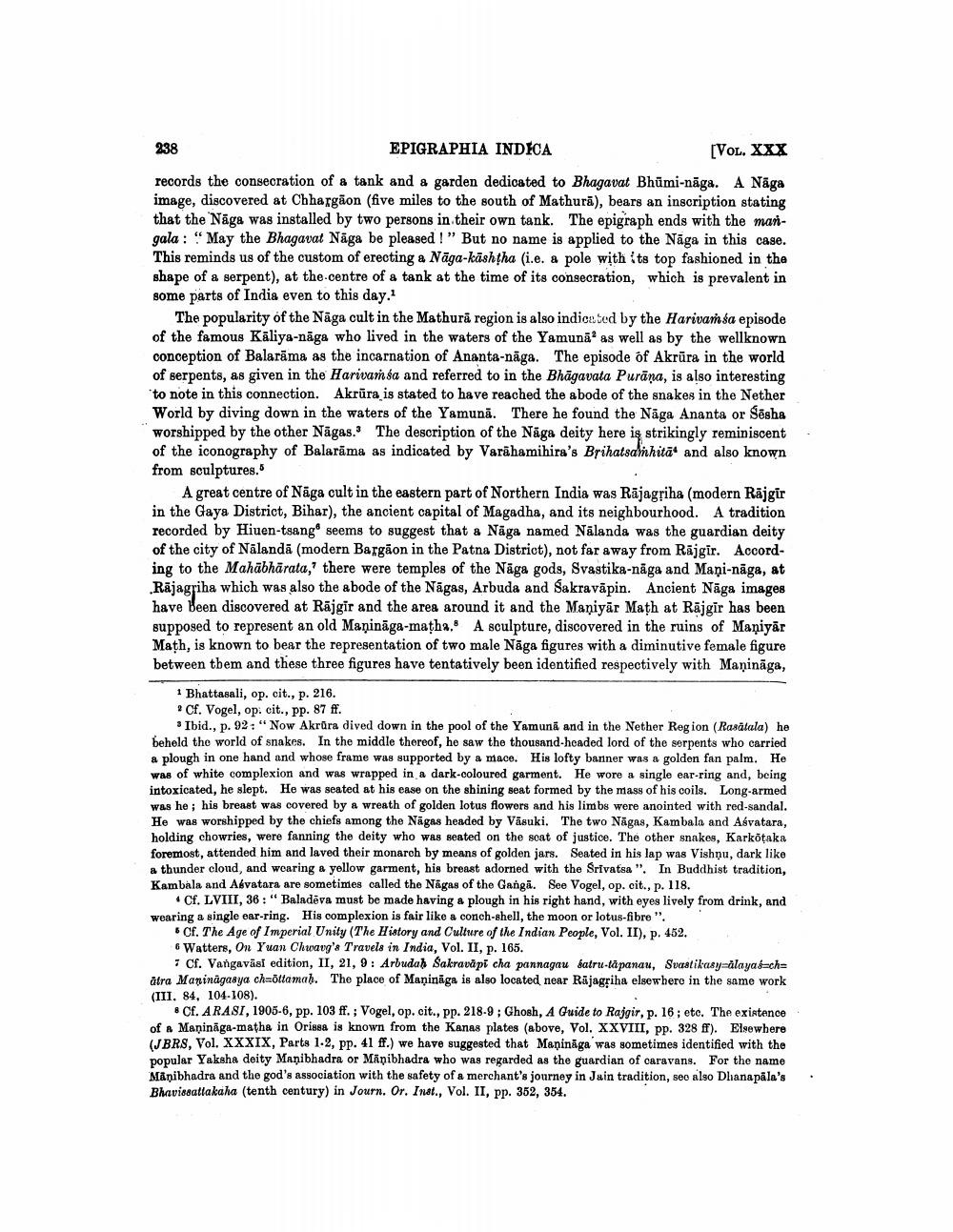________________
238
EPIGRAPHIA INDICA
[VOL. XXX
records the consecration of a tank and a garden dedicated to Bhagavat Bhümi-nāga. A Nāga image, discovered at Chhargaon (five miles to the south of Mathura), bears an inscription stating that the Naga was installed by two persons in their own tank. The epigraph ends with the mangala: "May the Bhagavat Naga be pleased!" But no name is applied to the Naga in this case. This reminds us of the custom of erecting a Näga-kashtha (i.e. a pole with its top fashioned in the shape of a serpent), at the centre of a tank at the time of its consecration, which is prevalent in some parts of India even to this day.1
The popularity of the Naga cult in the Mathura region is also indicated by the Harivam sa episode of the famous Kaliya-naga who lived in the waters of the Yamuna as well as by the wellknown conception of Balarama as the incarnation of Ananta-naga. The episode of Akrura in the world of serpents, as given in the Harivamsa and referred to in the Bhāgavata Purana, is also interesting to note in this connection. Akrura is stated to have reached the abode of the snakes in the Nether World by diving down in the waters of the Yamuna. There he found the Naga Ananta or Sesha worshipped by the other Nagas. The description of the Naga deity here is strikingly reminiscent of the iconography of Balarama as indicated by Varahamihira's Brihatsamhita and also known from sculptures.5
A great centre of Naga cult in the eastern part of Northern India was Rājagriha (modern Rājgir in the Gaya District, Bihar), the ancient capital of Magadha, and its neighbourhood. A tradition recorded by Hiuen-tsang seems to suggest that a Naga named Nalanda was the guardian deity of the city of Nalanda (modern Bargaon in the Patna District), not far away from Rajgir. According to the Mahabharata, there were temples of the Naga gods, Svastika-naga and Mani-naga, at Rajagriha which was also the abode of the Nagas, Arbuda and Sakravapin. Ancient Naga images have been discovered at Rajgir and the area around it and the Maniyar Math at Rajgir has been supposed to represent an old Maninaga-matha. A sculpture, discovered in the ruins of Maniyar Math, is known to bear the representation of two male Naga figures with a diminutive female figure between them and these three figures have tentatively been identified respectively with Maninaga,
1 Bhattasali, op. cit., p. 216.
2 Cf. Vogel, op. cit., pp. 87 ff.
Ibid., p. 92: "Now Akrura dived down in the pool of the Yamuna and in the Nether Region (Rasātala) he beheld the world of snakes. In the middle thereof, he saw the thousand-headed lord of the serpents who carried a plough in one hand and whose frame was supported by a mace. His lofty banner was a golden fan palm. He was of white complexion and was wrapped in a dark-coloured garment. He wore a single ear-ring and, being intoxicated, he slept. He was seated at his ease on the shining seat formed by the mass of his coils. Long-armed was he; his breast was covered by a wreath of golden lotus flowers and his limbs were anointed with red-sandal. He was worshipped by the chiefs among the Nagas headed by Vasuki. The two Nagas, Kambala and Asvatara, holding chowries, were fanning the deity who was seated on the seat of justice. The other snakes, Karkōṭaka foremost, attended him and laved their monarch by means of golden jars. Seated in his lap was Vishņu, dark like a thunder cloud, and wearing a yellow garment, his breast adorned with the Srivatsa". In Buddhist tradition, Kambala and Aévatara are sometimes called the Nagas of the Ganga. See Vogel, op. cit., p. 118.
Cf. LVIII, 36: "Baladeva must be made having a plough in his right hand, with eyes lively from drink, and wearing a single ear-ring. His complexion is fair like a conch-shell, the moon or lotus-fibre ".
Cf. The Age of Imperial Unity (The History and Culture of the Indian People, Vol. II), p. 452.
6 Watters, On Yuan Chwavg's Travels in India, Vol. II, p. 165.
7 Cf. Vangaväsi edition, II, 21, 9: Arbudaḥ Sakravapi cha pannagau batru-tapanau, Svastikasy-alayas-ch= atra Maninagasya ch-ottamaḥ. The place of Maninaga is also located near Rajagriha elsewhere in the same work (III. 84, 104-108).
8 Cf. ARASI, 1905-6, pp. 103 ff.; Vogel, op. cit., pp. 218-9; Ghosh, A Guide to Rajgir, p. 16; etc. The existence of a Maninaga-matha in Orissa is known from the Kanas plates (above, Vol. XXVIII, pp. 328 ff). Elsewhere (JBRS, Vol. XXXIX, Parts 1-2, pp. 41 ff.) we have suggested that Maninaga was sometimes identified with the popular Yaksha deity Manibhadra or Manibhadra who was regarded as the guardian of caravans. For the name Manibhadra and the god's association with the safety of a merchant's journey in Jain tradition, see also Dhanapala's Bhavissallakaha (tenth century) in Journ. Or. Inst., Vol. II, pp. 352, 354.




